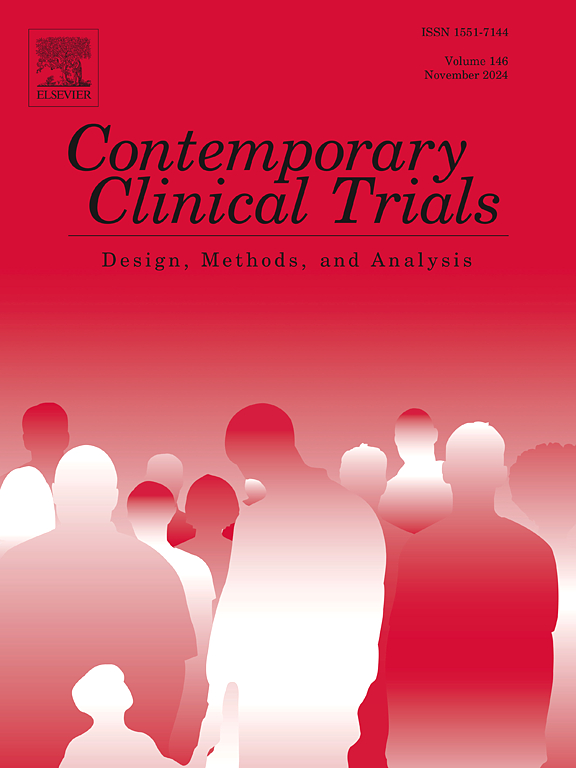评估疗效和毒性终点之间的相关性在贝叶斯优化II期设计中的作用
IF 1.9
3区 医学
Q3 MEDICINE, RESEARCH & EXPERIMENTAL
引用次数: 0
摘要
贝叶斯优化II期(BOP2)设计用于筛选新疗法的疗效和/或毒性,确定是否值得进一步开发。采用BOP2设计联合监测药效-毒性权衡时,两者之间的相关性对于在控制I型误差的同时获得良好的统计功率性能起着重要作用。然而,在实践中,这种相关性通常是未知的,这给试验设计和数据分析带来了挑战。在本研究中,选择phi系数来衡量相关性。首先在设计阶段和数据分析阶段分别评估了功效-毒性权衡对BOP2设计功率的影响,然后进行了整体考虑。在设计阶段,我们观察到功率随phi的增加而增加。在进行数据分析阶段的灵敏度分析时,我们发现给定预先确定的停止边界,功率随着phi的增加而减小。仿真表明,当设计阶段的假设phi值超过数据分析阶段的真实phi值时,会出现I型误差过大的情况。相反,在数据分析阶段,当假设的phi低于真实的phi时,会发生控制型I误差的功率不足。为了在设计中获得控制第一类误差下的功率,我们建议在功效和毒性可能呈正相关的情况下使用独立相关。相反,对于可能为负相关的情况,建议取接近下界的phi值。本文章由计算机程序翻译,如有差异,请以英文原文为准。
Assessing the role of correlation between efficacy and toxicity endpoints in the performance of Bayesian optimal phase II design
Bayesian optimal phase II (BOP2) design serves to screen the efficacy and/or toxicity of a new treatment, determining whether it warrants further development. When employing the BOP2 design to jointly monitor the efficacy-toxicity tradeoff, the correlation between them plays an important role in achieving good performance on the statistical power while controlling Type I error. However, in practice, this correlation is usually unknown, posing challenges in the trial design and data analysis. In this study, the phi coefficient is chosen to measure the correlation. The influence of the efficacy-toxicity tradeoff on the power of BOP2 designs is first evaluated in the design stage and the data analysis stage, separately, then, overall considerations are given. In the design stage, we observe that the power increases as phi increases. Upon performing the sensitivity analysis in the data analysis stage, we find that the power decreases as phi increases given the pre-determined stopping boundaries. Simulations demonstrate instances of overpowering with inflated Type I error when the assumed phi in the design stage exceeds the true phi in the data analysis stage. Conversely, underpowering occurs with controlled Type I error when the assumed phi is lower than the true phi in the data analysis stage. To obtain the power under controlled Type I error in design, we recommend the use of independent correlation when the efficacy and toxicity are likely to be positively correlated. Conversely, for cases of likely negative correlation, taking a phi value close to the lower bound is advisable.
求助全文
通过发布文献求助,成功后即可免费获取论文全文。
去求助
来源期刊
CiteScore
3.70
自引率
4.50%
发文量
281
审稿时长
44 days
期刊介绍:
Contemporary Clinical Trials is an international peer reviewed journal that publishes manuscripts pertaining to all aspects of clinical trials, including, but not limited to, design, conduct, analysis, regulation and ethics. Manuscripts submitted should appeal to a readership drawn from disciplines including medicine, biostatistics, epidemiology, computer science, management science, behavioural science, pharmaceutical science, and bioethics. Full-length papers and short communications not exceeding 1,500 words, as well as systemic reviews of clinical trials and methodologies will be published. Perspectives/commentaries on current issues and the impact of clinical trials on the practice of medicine and health policy are also welcome.

 求助内容:
求助内容: 应助结果提醒方式:
应助结果提醒方式:


